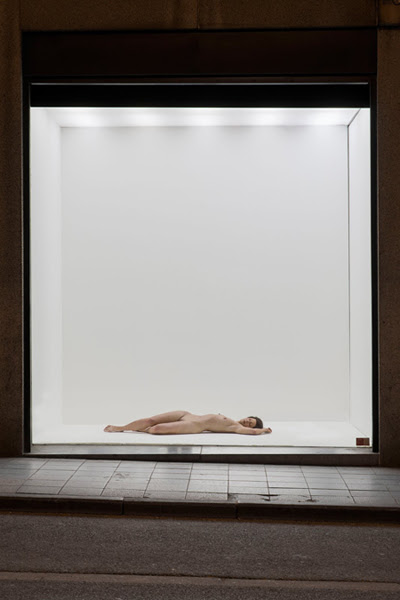
About
John De Andrea
11.06.14 → 31.08.14
"I always believed in the real thing," sculptor John DeAndrea says of his ultra-life like work, "lf I could make it breathe I'd say. 'l've done a good days work now! " For more than twenty years, John DeAndrea's sculpture has extended realism, his inheritance from ancient Greece and Renaissance Italy, to its extreme. His figures remain the last word in illusionism, enduring chilly gallery settings with serenity.
Yet the artist's own myth is Promethean. His is the legend of the creator who challenges the Gods themselves to favor or condemn his intentions. Dedalus makes a statue of a hero so lifelike that Hercules takes it for a rival and knocks it down. Aphrodite breathes life into Pygmalion's ivory Galatea. There are Dr Frankenstein's furtive experiments and Coppelius's wonderful doll.
DeAndrea's astonishingly realistic figures are cast from life and rendered in minute detail. Hair is set into plastic scalps, brows and pubes a few strands at a time. The oil polychrome 'skins' reveal moles, tiny veins, and scars. For draped works, garments are taken apart and reassembled on the fully painted bodies. In the nudes, pressure marks on the flesh made by clothing are preserved by the casting material.
These amazing simulacra are among the most enduring legacies of Photorealism, and they have gained John DeAndrea an international reputation. Usually the viewer's first reaction to DeAndrea's work is shock at seeing an unclothed person in the decorous space of museum or gaIlery. If there were nothing beyond this startling evocation of the human gestalt, DeAndrea's figures would offer only a superficial, transient, and vaguely erotic sensation. They would be three-dimensional pinups, but they are not. DeAndrea's work has an abiding fascination that derives from the way it reconciles apparently conflicting esthetic tendencies.
On one hand, much of DeAndrea's work perpetuates the artistic tradition of the ideaized nude. Linda (1983) and Joan (1992) are sisters of the long-legged, high-breasted Aphrodites revered by the Creeks, and the recumbent nymphs and goddesses of Titian and Giorgione. DeAndrea continues this tradition by choosing youthful models who are firm and well muscled. They are individuals whom nature has fashioned close to the Western canon of beauty.
On the other hand, the fact that the sculptures are cast directly from the models' bodies ensures that every birthmark and wrinkle, every flaw, however small will be reproduced in plastic and paint. This insistent individualism and deviation from perfection run counter to every notion of an ideal art. Realism is by definition opposed to idealism, yet they harmonize in John DeAndrea's work.
In the most fundamental sense of the term, DeAndreas art is also Classical. His sculptures are direct descendants of the rouged, gilded, and waxy idols we know (though we scarcely believe) the great stone sculptures of Classical antiquity to have been when new. The artist's sensibility is at the same time peculiarly Mediterranean-another paradox, for this is an anti-Classical tendency-and his figures likewise are related to the illusionistic madonnas and saints of Spain, Italy, and Mexico with their "real" clothes and hair, and crystal tears. However, DeAndreas figures are wholly secular, with none of the sentimental passion that typifies these religious images.
Indeed, the poignancy of DeAndrea's sculpture derives from its very coolness, its lack of eros. Dressed or naked, the figures make no attempt to engage the viewer. Even those with energetic or agonized poses remain self-contained, introverted. Eyes are downcast or closed-or look into an indefinite middle distance as if their world is another dimension in which the visitor has no reality. Even the exquisite Mother (1995) gazes at her sleeping child with reserve. It is as if these enigmatic icons meditate on what the flesh-that is, our flesh-is heir to.